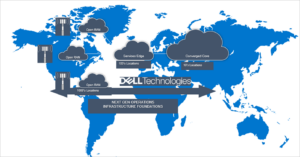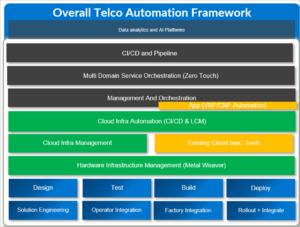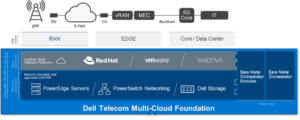The promise of improved TCO and new innovative solutions is driving telecom network transformation. Networks that meet visions of automation, scalability, higher performance and intelligence have already become possible by a new era of architectures and solutions based on 5G, Edge, Multi Cloud and DevOps based operating models.

However, this transition will not be a single leap but rather a number of consistent and iterative steps starting from setting the right foundation layer and then moving to upper layers including applications, OSS and BSS.
What it actually means is that for a long-time telcos will need to manage a hybrid network which is a mix of legacy, virtualised and containerised workloads split across many clouds and appliance-based infrastructures. In this model, both integration and management become vital requirements towards enabling the “radical automation” of networks.
In addition to newly built systems, telcos own a massive fleet of proprietary systems with legacy technologies and technical debts built over generations that need to be integrated. All of these hybrid systems will need to comply to telecom standards that span security, regulatory and data sovereignty requirements.
These challenges highlight the need to build the right operational model – one that can adapt and co-exist with current models which till now have been heavily reliant on traditional telecom vendors tools and services.
Why telecom automation will be more complex than traditional cloud infrastructure-as-code (IaC) tools
During the last decade we have seen rapid IT transformation supported by rich innovation in cloud management ecosystem. Enterprises have the ability to select automation frameworks and tools from a plethora of options widely adopted in the industry to address automation and lifecycle management requirements such as Ansible, Juju, Terraform, Heat, Python, etc.
However, their adoption in telecoms proved that, while the application VNFs and CNFs can be rolled out quickly, day 2 tasks still rely heavily on an array of “workload and infrastructure driven” management tools. These tools are used at multiple layers of the stack and across multiple cloud stacks deployed in the network. They perform a range of tasks including,
- Hardware management
- Virtual infrastructure and cloud orchestration and management
- FCAPS (Fault, Configuration, Accounting, Performance and Security Management)
- Network Orchestration and Management
- Application and workload management
Defining Multi Cloud Architecture blueprint to enable Telco’s radical automation and Intelligence
Today’s Telecom customers need choices between public, private and hybrid clouds. They want to monetise their pole positions to achieve global scale. However, they are still not willing to compromise on SLAs for mission critical services to accelerate transformation in brown field networks.
Today, Dell Technologies is enabling customers to adopt a multi cloud architecture with emphasis on highly performant cloud and infrastructure layers as a foundation. This will enable telcos to address the fundamental requirement of integrating cloud native infrastructure into their existing networks with a promise of delivering a telco-grade operating model. Further, it will enable network DevSecOps models to deliver and manage telco applications at the speed of the cloud.

In order to help operators accelerate the adoption of a multi cloud network, Dell is partnering with VMware and RedHat to deliver validated reference architectures for VMware Telco Cloud Platform and Red Hat OpenShift Container Platform.
Earlier this year, Dell Technologies has taken this relationship one step further with the introduction of Dell Telecom Multi-Cloud Foundation. This demonstrates our commitment to simply the introduction of “Workload ready” clouds by automating deployment and life-cycle management of a telecom cloud to reduce operational costs while consistently meeting telecom SLAs. It supports all of the leading cloud platforms offering operators the flexibility to choose the best platform to meet workload requirements in the most cost-effective manner. This solution utilises our flagship Bare Metal Orchestration toolset to enable full-stack operational automation at the scale and complexity of telecom network operators.

At Dell Technologies, we recognise that telecom transformation requires new partnerships and new technologies to succeed. Having hundreds of organisations digitally transform, Dell is committed to helping our telco customers modernise their network with a sound, multi cloud foundation.


